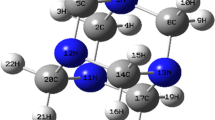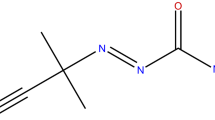Abstract
The thermal decomposition behaviors of 2,4,6-Trinitrotoluene (TNT) and 1-methoxy-2,4-dinitro-benzene (DNAN) were studied by using a NETSCH company accelerating rate calorimetry. Hazard indicators such as onset temperature, adiabatic temperature rise, initial self-heat temperature, maximum self-heating rate, and time-to-maximum temperature rise rate have been determined directly. The kinetic parameters, such as the activation energy (E a) and the pre-exponential factor (A) were studied from the measured self-heating rate data by assuming order reaction.




Similar content being viewed by others
Abbreviations
- Φ :
-
Thermal inertia factor
- T 0 :
-
Initial self-heat temperature (°C)
- T f :
-
Final decomposition temperature (°C)
- ΔT ad :
-
Adiabatic temperature rise (°C)
- m 0 :
-
Initial temperature rise rate (°C min−1)
- m m :
-
Maximum temperature rise rate (°C min−1)
- T m :
-
Temperature of maximum temperature rise rate (°C)
- θ m :
-
Time of maximum temperature rise rate (min)
- E a :
-
The apparent activation energy (kJ mol−1)
- R :
-
The gas constant
- A :
-
Pre-exponential factor
References
Agrawal JP, Hodgson RD. Organic chemistry of explosives. Chichester: John Wiley & Sons; 2007.
Akhavan JA. Chemistry of explosives. Cambridge: The Royal Society of Chemistry; 1998.
Pasupala R, DiliP MB, Girish MG, Surya PT, Arun KS. Review on melt cast explosives. Propellants Explos Pyrotech. 2011;36:393–403.
Beanard PW, Fouche FC, Bezuidenhout HC. Less sensitive TNT-based Formulations, Australian Explosive Ordnance Symposium (parari’ 1997), Canberra, Australia, November, 1997; 12–4.
Nicolich S, Niles J, Ferlazzo P, Doll D, Braithwaite P, Rausmussen N, Ray M, Gunger M, Spencer A. Recent developments in reduced sensitivity melt pour explosives. In: 34th int. Annual Conference of ICT Karlsruhe, Germany, 2003; 24–7.
Arthur P, Craig W. Ageing of Australian DNAN based melt-cast insensitive explosives. Propellants Exlos Pyrotech. 2016;41:555–61.
Zhang GY, ** SH, Li LJ, Li YK, Wang DQ, Li W, Zhang T, Shu QH. Thermal hazard assessment of 4,10-dinitro-2,6,8,12-tetraoxa-4,10-diazaisowurtzitane (TEX) with accelerating rate calorimeter (ARC). J Therm Anal Calorim. 2016;126:467–71.
Zhang GY, ** SH, Li LJ, Li ZH, Shu QH, Wang DQ, Zhang B, Li YK. Evaluation of thermal Hazards and thermo-kinetic parameters of 3-amino-4-amidoximinofurazan by ARC and TG. J Therm Anal Calorim. 2016;126:1223–30.
Zhu JP, ** SH, Yu YH, Zhang CY, Li LJ, Chen SS, Shu QH. Evaluation of thermal hazards and thermo-kinetic parameters of N,N′-dinitro-4,4′-azo-Bis (1,2,4-triazolone) (DNZTO). Thermochim Acta. 2016;623:58–64.
Zhang CY, ** SH, Chen SS, Li LJ, Zhou C, Zhan Y, Shu QH. Thermal behavior and thermo-kinetic studies of 5,5′-bistetrazole-1,1′-diolate (1,1-BTO). J Therm Anal Calorim. 2017;129:1265–70.
Townsend DI, Tou JC. Thermal hazard evaluation by an accelerating rate calorimeter. Thermochim Acta. 1980;37:1–30.
Tou JC, Whiting LF. The thermokinetic performance of an accelerating rate calorimeter. Thermochim Acta. 1981;48:21–42.
Lu KT, Yang CC, Lin PC. The criteria of critical runaway and stable temperatures of catalytic decomposition of hydrogen peroxide in the presence of hydrochloric acid. J Hazard Mater. 2006;135:319–27.
Fu ZM, Koseki H, Iwata Y. Investigation on thermal stability of flavianic acid disodium salt. J Loss Prevent Proc. 2009;22:477–83.
Liu HP, Gu LY, Zhu P, Liu ZR, Zhou B. Effect of micro amount of Fe3+ on thermal explosion decomposition of hydrogen peroxide. Fire Sci Tech. 2012;31:554–7.
Zuo YF, Chang K, Chen J, Cheng KM, Wang XF, Fang YX. Characteristics of thermal decomposition of TEX. Chin J Energ Mater. 2006;14:387–8.
Liu RH, Chen WH, Hu YT. Safety principle and assessment technology for dangerous chemicals. Bei**g: Chemical Industry Press; 2004.
Zhang Z, Jiang H, Huang P. Study of hydrogen peroxide explosion mechanism and its prevention measures. J Saf Environ. 2007;7:108–10.
Liu Y, Yang Q, Chen LP, He ZQ, Lu Y, Chen WH. Thermal sensitivity of energetic materials characterized by accelerating rate calorimeter (ARC). Chin J Energ Mater. 2011;19:656–60.
Acknowledgements
Funding was provided by the Technology Innovation Program of Bei**g Institute of Technology of China (Grant No. 2017CX10003).
Author information
Authors and Affiliations
Corresponding author
Rights and permissions
About this article
Cite this article
Zhang, C., **, S., Ji, J. et al. Thermal hazard assessment of TNT and DNAN under adiabatic condition by using accelerating rate calorimeter (ARC). J Therm Anal Calorim 131, 89–93 (2018). https://doi.org/10.1007/s10973-017-6665-x
Received:
Accepted:
Published:
Issue Date:
DOI: https://doi.org/10.1007/s10973-017-6665-x




